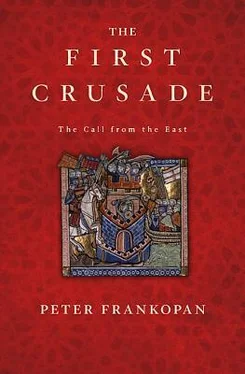Many scholars have argued that this upheaval within the Turkish Empire presented Alexios with the ideal opportunity to strengthen Byzantium’s position in Asia Minor. In fact, the opposite was the case. Malik-Shah’s death robbed the emperor of an invaluable ally at the worst possible moment. What is more, the problems over the succession meant there was a power vacuum in Anatolia which was quickly exploited by local Turkish warlords. This made things much more difficult for Alexios, who struggled to make an impression on the succession of Turkish leaders who were making the most of both their new-found freedom and the weakness of the Byzantine response.
By 1094, the situation was critical. At a church synod in Constantinople, attended by bishops from all over the empire, discussion turned to those with pastoral responsibilities in the east. Many were present in the capital not by choice but because they could not get back to their respective sees because of the Turks. Acknowledging the problems they faced, the emperor tartly noted that bishops from western regions had no such excuse, and ordered them to leave Constantinople and return to their duties. 37Bishops from Anatolia, it was acknowledged, could not be expected to do the same, and furthermore needed financial support while they remained in the capital, cut off from their sees. A resolution was duly passed to this effect. 38
The failure of Byzantine Asia Minor was universal: the collapse of the interior, together with the loss of the seaboard, meant that it was not possible to reach important locations such as Antioch either by land or by sea; John the Oxite, the patriarch of Antioch, was unable to travel to his see for several years. 39Town after town fell into Turkish hands in the early 1090s. According to Michael the Syrian, whose twelfth-century chronicle is one of the few sources to focus on this period, Tarsos, Mopsuetia, Anazarbos and all the other towns of Cilicia were taken around 1094/5. 40This corresponds with what the western knights found as they crossed Asia Minor not long afterwards. When they reached Plastencia, ‘a town of great splendour and wealth’, they found it besieged by the Turks, its inhabitants still holding out; 41a nearby town, Coxon, was also still in Christian hands. 42
The loss of the western coast of Asia Minor and of the rich river valleys of its hinterland was a catastrophe for Byzantium. Something had to be done urgently to reverse the series of setbacks and to lay a platform on which to build a later recovery; if not, it was likely that the eastern provinces would be lost forever. Attention turned to Nicaea, superbly fortified and controlling access to the interior as well as the land routes to the coast. Taking the city would be the key to any wider restoration of imperial control in the east; its retrieval now became the principal thrust of the emperor’s strategy.
Making an impression on the city was not easy: a masterpiece of defensive fortification, it was all but impregnable. As one Latin chronicler observed: ‘Nicaea has a very favourable site. It lies in the plain, yet is not far from the mountains, by which it is surrounded on almost every side ... Next to the city, and extending to the west, is a very wide lake of great length ... this is the best defence the city could have. A moat surrounds the walls on the other sides, and this is always full to overflowing by the influx of springs and streams.’ 43
Alexios knew that there was little prospect of taking the town by force. 44Apart from anything else, the Byzantine military was already overstretched. As John the Oxite had noted, a decade of near constant campaigning against the Normans and the Pechenegs had worn out the imperial forces and inflicted many casualties. 45In addition, the situation was still tense to the north of Constantinople. There was danger of an imminent attack on imperial territory from the Danube region by Cuman steppe nomads, while incursions by the Serbs across the north-western frontier were becoming increasingly troublesome. 46
Raising a force sufficiently large to move on Nicaea was one problem. Another was trying to make an impression on its defences. Byzantine siege warfare lagged a long way behind the west, where techniques had developed rapidly during the eleventh century. And then there was the question of who should take charge of operations against the city. Given the failure of Alexios’ policy in Asia Minor and the pressure on the empire as a whole, there was a real risk that a general in command of substantial resources might see an opportunity to try to take the throne for himself.
It was to Tatikios, his childhood friend, that Alexios turned, confident of his loyalty. In the middle of 1094, Tatikios arrived at Nicaea, supplied with instructions to engage any defender who dared make a sortie. He soon charged a group of 200 men who had come out to disperse the imperial force. This was the extent of his achievement, however: a morale boost, but of little tangible value. He achieved nothing more before withdrawing to Constantinople in haste after learning that a major Turkish expedition was closing in on Nicaea. 47This had been sent by Barkyaruq, one of the sons of Malik-Shah, who had finally triumphed over his rivals in Baghdad having the hutba declared to proclaim him as ruler in February 1094. 48
Barkyaruq’s intervention was deeply disturbing for Alexios as it became clear that its aim was not just to stamp the new sultan’s authority on emirs in Asia Minor, but to take possession of Nicaea. The emperor was not alone in his concern at the advance of the force under Bursuk, a particularly bloodthirsty commander: ‘the inhabitants of [Nicaea], and indeed Abu’l-Kasim himself saw that their condition was really desperate – it was impossible to hold out against Bursuk any more’. They took a bold decision; according to the Alexiad , ‘they got a message through to the emperor asking for help, saying that it was better to be called his slaves than to surrender to Bursuk. Without delay, the best available troops were sent [by the emperor] to their aid, with standards and silver-studded sceptres.’ 49
There was cool logic behind Alexios’ decision to help the governor of Nicaea, even though he had been the cause of problems for Byzantium over many years: ‘He calculated that providing help would bring about the ruin of Abu’l-Kasim’, reported Anna Komnene. ‘For when two enemies of the Roman Empire were fighting one another, it would pay him to support the weaker – not in order to make him more powerful, but to repel the one while taking the town from the other, a town that was not at the moment under Roman jurisdiction but would be incorporated in the Roman sphere by this means.’ 50Although Bursuk withdrew, frustrated by Nicaea’s defences, the respite was brief: reports were soon received in the city that another massive expedition ‘from the deep interior of the Turkish Empire’ was on its way. 51Abu’l-Kasim realised that it was only a matter of time before he was forced into submission; he was ready to listen to the emperor’s proposals about the handover of Nicaea.
Constantinople regularly received diplomatic missions and highranking visitors from foreign shores. In the tenth century, a text known as The Book of Ceremonies had been compiled providing instructions how these were to be dealt with, with the relative importance of the country in question underpinning the lavishness of the reception. 52The aim was to show the splendours of the capital and to underline the empire’s cultural, political and spiritual superiority. Alexios now used this tried and tested technique with Abu’l-Kasim. When the Turk was invited to Constantinople later in 1094, the emperor laid on a specially tailored schedule designed to impress the emir and show him the benefits of co-operating with the empire.
Читать дальше











